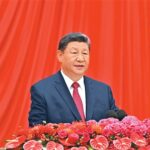President Xi Jinping, General Secretary of the Communist Party of China Central Committee, President of the State, and Chairman of the Central Military Commission, arrived in Lhasa by special plane at noon on the 20th to attend the celebration of the 60th anniversary of the establishment of the Tibet Autonomous Region. This marks the first time in the history of the Party and the state that a General Secretary of the Communist Party of China Central Committee, President of the State, and Chairman of the Central Military Commission has led a central delegation to Tibet for such an event, fully demonstrating the high importance the Party Central Committee places on Tibet’s work and its deep care for the cadres and people of all ethnic groups in Tibet.
Wang Huning, Member of the Standing Committee of the Political Bureau of the Communist Party of China Central Committee, Chairman of the National Committee of the Chinese People’s Political Consultative Conference, and Head of the Central Delegation, and Cai Qi, Member of the Standing Committee of the Political Bureau of the Communist Party of China Central Committee and Director of the General Office of the Communist Party of China Central Committee, arrived on the same flight.
In the early autumn of the Qinghai-Tibet Plateau, a cool breeze brought pleasant weather. At Lhasa Gonggar Airport, red flags fluttered, creating a warm atmosphere.
At around 12:00, the special plane carrying President Xi Jinping landed at Gonggar Airport. Crowds from various ethnic groups and sectors in Tibet, who had been waiting on the tarmac, cheered enthusiastically. President Xi stepped out of the cabin and waved to the welcoming crowd.
Wang Junzheng, Secretary of the Communist Party of China Tibet Autonomous Regional Committee, Yan Jinhai, Chairman of the Standing Committee of the Tibet Autonomous Regional People’s Congress, Karma Tseten, Chairman of the People’s Government of the Tibet Autonomous Region, and Liu Jiang, Secretary of the Leading Party Members’ Group of the Tibet Autonomous Regional Committee of the Chinese People’s Political Consultative Conference, among others, greeted him at the foot of the aircraft steps. As President Xi descended, Wang Junzheng presented a khata scarf, while ceremonial personnel offered chemar and barley wine. Representatives of various ethnic groups, dressed in festive attire, waved red flags and colorful bouquets, performed joyful traditional dances to welcome the General Secretary, and expressed their heartfelt blessings.
In the ancient city of Lhasa, filled with a festive atmosphere, colorful flags lined the main streets from the airport to the residence. People from all ethnic groups held red flags and khata scarves, cheering in unison to express their welcome and gratitude. President Xi opened the car window and waved frequently to the crowds along the route.
Li Ganjie, Member of the Political Bureau of the Communist Party of China Central Committee and Minister of the United Front Work Department, and Deputy Head of the Central Delegation; Zhang Guoqing, Member of the Political Bureau of the Communist Party of China Central Committee and Vice Premier of the State Council; Losang Jamcan, Vice Chairman of the Standing Committee of the National People’s Congress; Hu Chunhua, Vice Chairman of the National Committee of the Chinese People’s Political Consultative Conference; Zhang Shengmin, Member of the Central Military Commission; He Lifeng, Member of the Political Bureau of the Communist Party of China Central Committee and Vice Premier of the State Council; and Wang Xiaohong, Member of the Secretariat of the Communist Party of China Central Committee and State Councilor, who accompanied the event, arrived on the same flight.
Members of the Central Delegation arrived at the same time, including officials from relevant central and state organs, military units, and counterpart support provinces and cities for Tibet.

